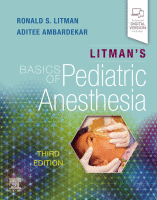Physical Address
304 North Cardinal St.
Dorchester Center, MA 02124

There are many features of the administration of general anesthesia that differ between children and adults. In this chapter, we discuss those differences, with an emphasis on anesthetic medications and ventilation strategies. We also review the importance of racial disparities…

In this chapter we review principles of pediatric difficult airway management, with a focus on those entities that cause anatomic or functional airway obstruction above the level of the glottis. We consider causes and treatments of anticipated and unanticipated difficult…

General anesthesiologists that occasionally anesthetize children should be intimately familiar with the anatomy of the pediatric upper airway. In this chapter, the pertinent features of the pediatric airway and the correct ways to manage the pediatric airway are detailed. Several…

This chapter reviews the importance of thermoregulation and temperature monitoring in anesthetized children. It addresses the significance of keeping children normothermic and will help the trainee understand why pediatric anesthesiologists become apoplectic when faced with the possibility that the small…

Four monitors are used for virtually every pediatric anesthesia case: pulse oximetry, capnography, electrocardiogram (ECG), and blood pressure measurement. These monitors are components of the Basic Monitoring Standards of the American Society of Anesthesiologists. Temperature monitoring is also performed except…

A variety of intravenous fluid and blood products are administered to children in the perioperative period. Indications include preoperative deficit replacement, ongoing maintenance requirements, fluid loss replacement, and treatment of anemia and hypovolemia. This chapter describes the use of these…

The “10 P” Checklist Cognitive aids, in the form of checklists, are techniques that ensure completeness with multistep processes and aid attention to detail. We devised the 10 P checklist to help anesthesia providers prepare for cases ( Table 13.1…

With the advent of antenatal steroids, surfactant therapy, and the overall improvement in care of extremely premature infants, mortality from medical problems of prematurity has decreased. However, as survival rates of premature infants increase, the incidence of chronic medical conditions…

In the last several decades, the incidence of prematurity in the United States has risen to 11.5%. Maternal risk factors for prematurity include absence of prenatal care, low socioeconomic status, tobacco abuse, poor nutrition and genitourinary tract infections, to name…

Diabetes Mellitus The endocrine condition most frequently encountered in the perioperative period in children is diabetes mellitus. Diabetes mellitus is the result of an absolute or functional deficiency of insulin production by the pancreas. In type 1 diabetes, this deficiency…